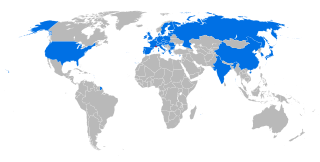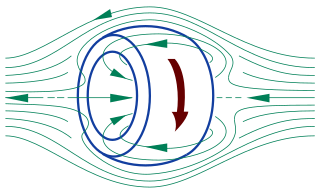
Nuclear fusion is a reaction in which two or more atomic nuclei, usually deuterium and tritium, combine to form one or more different atomic nuclei and subatomic particles. The difference in mass between the reactants and products is manifested as either the release or absorption of energy. This difference in mass arises due to the difference in nuclear binding energy between the atomic nuclei before and after the reaction. Nuclear fusion is the process that powers active or main-sequence stars and other high-magnitude stars, where large amounts of energy are released.

Fusion power is a proposed form of power generation that would generate electricity by using heat from nuclear fusion reactions. In a fusion process, two lighter atomic nuclei combine to form a heavier nucleus, while releasing energy. Devices designed to harness this energy are known as fusion reactors. Research into fusion reactors began in the 1940s, but as of 2024, no device has reached net power, although net positive reactions have been achieved.
This timeline of nuclear fusion is an incomplete chronological summary of significant events in the study and use of nuclear fusion.

ITER is an international nuclear fusion research and engineering megaproject aimed at creating energy through a fusion process similar to that of the Sun. Upon completion of construction of the main reactor and first plasma, planned for late 2025, it will be the world's largest magnetic confinement plasma physics experiment and the largest experimental tokamak nuclear fusion reactor. It is being built next to the Cadarache facility in southern France. ITER will be the largest of more than 100 fusion reactors built since the 1950s, with ten times the plasma volume of any other tokamak operating today.

Inertial electrostatic confinement, or IEC, is a class of fusion power devices that use electric fields to confine the plasma rather than the more common approach using magnetic fields found in magnetic confinement fusion (MCF) designs. Most IEC devices directly accelerate their fuel to fusion conditions, thereby avoiding energy losses seen during the longer heating stages of MCF devices. In theory, this makes them more suitable for using alternative aneutronic fusion fuels, which offer a number of major practical benefits and makes IEC devices one of the more widely studied approaches to fusion.

Aneutronic fusion is any form of fusion power in which very little of the energy released is carried by neutrons. While the lowest-threshold nuclear fusion reactions release up to 80% of their energy in the form of neutrons, aneutronic reactions release energy in the form of charged particles, typically protons or alpha particles. Successful aneutronic fusion would greatly reduce problems associated with neutron radiation such as damaging ionizing radiation, neutron activation, reactor maintenance, and requirements for biological shielding, remote handling and safety.

Magnetic confinement fusion (MCF) is an approach to generate thermonuclear fusion power that uses magnetic fields to confine fusion fuel in the form of a plasma. Magnetic confinement is one of two major branches of controlled fusion research, along with inertial confinement fusion.

A field-reversed configuration (FRC) is a type of plasma device studied as a means of producing nuclear fusion. It confines a plasma on closed magnetic field lines without a central penetration. In an FRC, the plasma has the form of a self-stable torus, similar to a smoke ring.
The polywell is a proposed design for a fusion reactor using an electric and magnetic field to heat ions to fusion conditions.
General Fusion is a Canadian company based in Vancouver, British Columbia, which is developing a fusion power device based on magnetized target fusion (MTF). The company was founded in 2002 by Dr. Michel Laberge. The company has more than 150 employees in three countries, with additional centers co-located with fusion research laboratories near London, and Oak Ridge, Tennessee, US.
TAE Technologies, formerly Tri Alpha Energy, is an American company based in Foothill Ranch, California developing aneutronic fusion power. The company's design relies on an advanced beam-driven field-reversed configuration (FRC), which combines features from accelerator physics and other fusion concepts in a unique fashion, and is optimized for hydrogen-boron fuel, also known as proton-boron or p-11B. It regularly publishes theoretical and experimental results in academic journals with hundreds of publications and posters at scientific conferences and in a research library hosting these articles on its website. TAE has developed five generations of original fusion platforms with a sixth currently in development. It aims to manufacture a prototype commercial fusion reactor by 2030.
Direct energy conversion (DEC) or simply direct conversion converts a charged particle's kinetic energy into a voltage. It is a scheme for power extraction from nuclear fusion.

Sir Steven Charles Cowley is a British theoretical physicist and international authority on nuclear fusion and astrophysical plasmas. He has served as director of the United States Department of Energy (DOE) Princeton Plasma Physics Laboratory (PPPL) since 1 July 2018. Previously he served as president of Corpus Christi College, Oxford, since October 2016. and head of the EURATOM / CCFE Fusion Association and chief executive officer of the United Kingdom Atomic Energy Authority (UKAEA).
Norman Rostoker was a Canadian plasma physicist known for being a pioneer in developing clean plasma-based fusion energy. He co-founded TAE Technologies in 1998 and held 27 U.S. Patents on plasma-based fusion accelerators.
Tihiro Ohkawa was a Japanese physicist whose field of work was in plasma physics and fusion power. He was a pioneer in developing ways to generate electricity by nuclear fusion when he worked at General Atomics. Ohkawa died September 27, 2014, in La Jolla, California, at the age of 86.
Colliding beam fusion (CBF), or colliding beam fusion reactor (CBFR), is a class of fusion power concepts that are based on two or more intersecting beams of fusion fuel ions that are independently accelerated to fusion energies using a variety of particle accelerator designs or other means. One of the beams may be replaced by a static target, in which case the approach is termed accelerator based fusion or beam-target fusion, but the physics is the same as colliding beams.
John Robert Cary is a professor of physics at the University of Colorado Boulder and CEO of Tech-X Corporation, which he co-founded in 1994.
Toshiki Tajima is a Japanese theoretical plasma physicist known for pioneering the laser wakefield acceleration technique with John M. Dawson in 1979. The technique is used to accelerate particles in a plasma and was experimentally realized in 1994, for which Tajima received several awards such as the Nishina Memorial Prize (2006), the Enrico Fermi Prize (2015), the Robert R. Wilson Prize (2019), the Hannes Alfvén Prize (2019) and the Charles Hard Townes Award (2020).
The history of nuclear fusion began early in the 20th century as an inquiry into how stars powered themselves and expanded to incorporate a broad inquiry into the nature of matter and energy, as potential applications expanded to include warfare, energy production and rocket propulsion.







